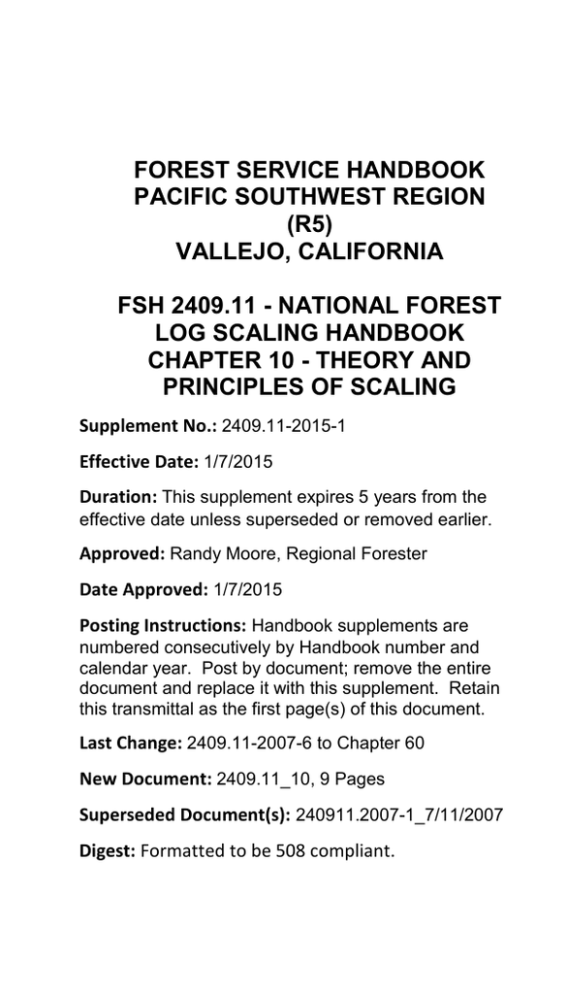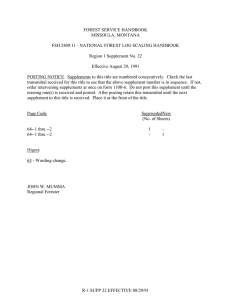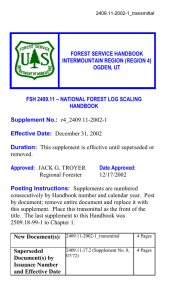FOREST SERVICE HANDBOOK PACIFIC SOUTHWEST REGION (R5) VALLEJO, CALIFORNIA
advertisement

FOREST SERVICE HANDBOOK PACIFIC SOUTHWEST REGION (R5) VALLEJO, CALIFORNIA FSH 2409.11 - NATIONAL FOREST LOG SCALING HANDBOOK CHAPTER 10 - THEORY AND PRINCIPLES OF SCALING Supplement No.: 2409.11-2015-1 Effective Date: 1/7/2015 Duration: This supplement expires 5 years from the effective date unless superseded or removed earlier. Approved: Randy Moore, Regional Forester Date Approved: 1/7/2015 Posting Instructions: Handbook supplements are numbered consecutively by Handbook number and calendar year. Post by document; remove the entire document and replace it with this supplement. Retain this transmittal as the first page(s) of this document. Last Change: 2409.11-2007-6 to Chapter 60 New Document: 2409.11_10, 9 Pages Superseded Document(s): 240911.2007-1_7/11/2007 Digest: Formatted to be 508 compliant. FSH 2409.11 - NATIONAL FOREST LOG SCALING HANDBOOK CHAPTER 10 - THEORY AND PRINCIPLES OF SCALING Supplement No.:2409.11-2015-1 - Effective Date: 1/7/2015 12 - General Principles of Forest Service Scaling Issue all scalers and check scalers in Region 5 who scale National Forest logs a copy of this handbook. Scalers shall follow the handbook rules as supplemented by the following instructions. Scalers shall scale logs as they are presented according to timber sale Contract specifications. The Forest Service Representative is responsible for determining if the material presented for scaling has been bucked and removed within the terms of the Timber Sale Contract. Scale and charge for logs or portions of logs presented for scaling which meet or exceed all the minimum piece specifications in A2 of the Timber Sale Contract. Do not alter scaling practices unless instructed in writing to do so by the Contracting Officer or Forest Service Representative. 16 - Product or Piece Specifications The Forest Service Representative shall complete and distribute form R5-2400-53, Scaler’s Information to each scaling location or scaling organization at least five days prior to the scaling of logs. This form provides contract information pertinent to the scaling of products from each timber sale. Scalers must have current Scaler’s Information forms (R5-2400-53) on hand for each contract being scaled. The Forest Service Representative shall determine if logs are being purposely bucked shorter than the contract minimum length and shall notify the Scaling Page 2 FSH 2409.11 - NATIONAL FOREST LOG SCALING HANDBOOK CHAPTER 10 - THEORY AND PRINCIPLES OF SCALING Supplement No.:2409.11-2015-1 - Effective Date: 1/7/2015 Organization or the Forest Service scaler in writing to scale such logs for payment. Scale and charge for logs with diameters below the contract minimum based on the volume determined from the point on the log where it first meets the minimum diameter, provided the remainder of the log meets or exceeds all the other minimums listed in A2 of the contract. 17 - Log Measurements 17.1 - Log Lengths Scalers shall measure the length on as many logs as necessary for accurate length determination. Use scaler judgment to assign lengths to hidden logs which cannot be measured. 17.12 - How to Measure Lengths Determine log length by measuring the shortest distance between the log ends; measure short side to short side. In butt logs, disregard undercuts in establishing log length. Determine lengths of logs with broken ends or evidence of breakage in one or both ends as follows: 1. On logs with both ends wholly or partially bucked, measure the length from saw cut to saw cut. Record the scaling length in even two foot multiples. Do not record or charge for overtrim or odd lengths on such logs. Page 3 FSH 2409.11 - NATIONAL FOREST LOG SCALING HANDBOOK CHAPTER 10 - THEORY AND PRINCIPLES OF SCALING Supplement No.:2409.11-2015-1 - Effective Date: 1/7/2015 a. Record as 18’ log and make required deduction for breakage. b. Record as 16’ log and make any required deduction for breakage. 2. For broken end logs with no evidence of a saw cut on one or both ends, measure from a point on the log where one-fourth or more of the scaling cylinder will produce boards of the recorded scaling length. This established length shall be in even two foot multiples. a. Record as 16’ log and make any required deduction for breakage. Page 4 FSH 2409.11 - NATIONAL FOREST LOG SCALING HANDBOOK CHAPTER 10 - THEORY AND PRINCIPLES OF SCALING Supplement No.:2409.11-2015-1 - Effective Date: 1/7/2015 b. Record as 16’ log with no deduction for breakage. Page 5 FSH 2409.11 - NATIONAL FOREST LOG SCALING HANDBOOK CHAPTER 10 - THEORY AND PRINCIPLES OF SCALING Supplement No.:2409.11-2015-1 - Effective Date: 1/7/2015 17.17 - Log Volumes, Board Feet Diameter factor tables for Scribner Decimal C board foot volumes published in the Official Log Scaling and Grading Rules Handbook, and used by all Scaling Organizations in the Northwestern United States, may be used in California in lieu of the volume tables published in this handbook. The volumes may vary +/- 10 board feet on logs of a few sizes from those listed in Appendix II or III of this handbook. The +/10 board feet variance has a balancing out effect and, over a number of logs of different sizes, has proven to be insignificant. Volume tables based on diameter factors are also available in computers used for scaling. Upon demand the computer will print volume tables. 17.2 - Trim Allowance See FSH 2409.11 Appendix 16. 17.3 - Log Diameters Scalers shall measure and establish “average round log diameter” on half logs or slabs of logs split lengthwise in the following manner (also see section 45 - Special Sectional Problems): 1. When the portion of the log is definitely a half of the original round log and the approximate round log diameter can be measured, use that diameter and calculate as a round log. Take ½ the calculated volume and establish the “average round log diameter”. For example: Page 6 FSH 2409.11 - NATIONAL FOREST LOG SCALING HANDBOOK CHAPTER 10 - THEORY AND PRINCIPLES OF SCALING Supplement No.:2409.11-2015-1 - Effective Date: 1/7/2015 Log measures 16’ × 30” Sound Original Log Gross Scale = 660 Bd. Ft. ½ log = 330 bd. Ft. “Average round log diameter” for a 16’ log with 330 bd. Ft. = 22 inches Record this ½ log as a 16’ × 22” log. Calculate and subtract any defect present from the 330 Bd. Ft. gross scale. 2. When the portion of a log is almost a square: Take a diameter on a diagonal from one corner to the opposite and use that measurement as the round log diameter. For example: A nearly square piece 16’ long has a diagonal measurements of 20” and 21.” The gross scale would be that of a 16’ × 20” = 208bd. Ft. 3. For pieces other than square or half-logs: Measure the short way, then measure the long way; and divide the total by two and use that figure as the “average round log diameter. For example: A 16’ slab measures 16” the short way and 24” the long way, or a 20” average. Record this log as a 16’ × 20” log having a gross scale of 280 Bd. Ft. Page 7 FSH 2409.11 - NATIONAL FOREST LOG SCALING HANDBOOK CHAPTER 10 - THEORY AND PRINCIPLES OF SCALING Supplement No.:2409.11-2015-1 - Effective Date: 1/7/2015 17.43 - Taper in butt Logs The standard allowance for butt logs in Region 5, except for incense-cedar logs, is as follows: Butt Log Scaling Length 21’ to 27’ inclusive 28’ to 40’ inclusive 41’ to 51’ inclusive over 51’ Total Taper Allowance 2” 4” 6” Determine actual taper by measuring the diameter of both ends of the log disregarding excessive butt flare, by projecting the normal taper of the log through the flared area. See exhibit 01. The standard taper for incense-cedar butt logs is as follows: Butt Log Scaling Length 21’ to 33’ inclusive 34’ to 46’ inclusive 47’ to 51’ inclusive Over 51’ Total Taper Allowance 6” 8” 10” Determine actual taper by measuring the diameter of both ends of the log disregarding excessive butt flare, by projecting the normal taper of the log through the flared area. See exhibit 01. Page 8 FSH 2409.11 - NATIONAL FOREST LOG SCALING HANDBOOK CHAPTER 10 - THEORY AND PRINCIPLES OF SCALING Supplement No.:2409.11-2015-1 - Effective Date: 1/7/2015 17.43 - Exhibit 01 TECHNIQUE FOR MEASURING LARGE END OF BUTT LOGS 1. Determine that a log is a butt log. When questionable, a log is a butt log if three of the following six conditions are identified: a. Excessive flare. b. Flutes. c. Paint marks. d. Limbs absent. e. Thick bark. f. Hinge. 2. Also, consider shear or circular saw marks left by mechanical fellers as a condition when logs are known to be from sales harvested by mechanical fellers. 3. Size up large end and find narrow axis. 4. Measure narrow axis and: a. Adjust measurement downward, if necessary, to allow for any excessive flare. b. On egg-shaped logs, it may be necessary to add one or more inches to obtain the actual taper*. 5. For butt logs that have extreme abnormalities such as serious cat face, excessive swell, or other conditions that do not permit proper narrow axis measurement, establish the large Page 9 FSH 2409.11 - NATIONAL FOREST LOG SCALING HANDBOOK CHAPTER 10 - THEORY AND PRINCIPLES OF SCALING Supplement No.:2409.11-2015-1 - Effective Date: 1/7/2015 end diameter by measuring the small end and adding the amount of estimated taper*. When possible, verify the butt measurement by checking the diameter at the small end of the butt segment. To do this, lay the scale stick or tape across the log at the small end and read the measurement, allowing for bark thickness. This small end butt segment measurement should be very close to the diameter obtained from the proper taper rule. When scale data is submitted for automatic data processing, the computer is programmed to allow the proper taper of each butt log on logs 21’ to 51’ in length. Butt logs over 51’ in scaling length will be assigned a large end diameter based on the above techniques. P a g e 10


